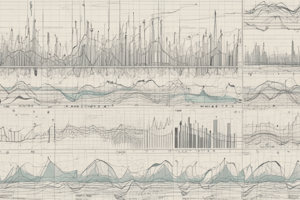Podcast
Questions and Answers
The population refers to a small group of items taken from a larger group of interest.
The population refers to a small group of items taken from a larger group of interest.
False (B)
An experimental unit is the object upon which data is collected.
An experimental unit is the object upon which data is collected.
True (A)
Descriptive statistics include methods for predicting future outcomes based on sample data.
Descriptive statistics include methods for predicting future outcomes based on sample data.
False (B)
A variable in statistical analysis refers to the characteristic of an individual experimental unit.
A variable in statistical analysis refers to the characteristic of an individual experimental unit.
A sample consists of all the individuals within a particular population.
A sample consists of all the individuals within a particular population.
Inferential statistics involve summarizing the main features of a dataset.
Inferential statistics involve summarizing the main features of a dataset.
Charts and tables are methods used to present data in statistical analysis.
Charts and tables are methods used to present data in statistical analysis.
An example of a sample could be a randomly selected group of 100 individuals from a population.
An example of a sample could be a randomly selected group of 100 individuals from a population.
Quantitative data is classified into categories.
Quantitative data is classified into categories.
Qualitative data includes information such as the college major of each student.
Qualitative data includes information such as the college major of each student.
Direct observation is a method that can involve complete participant observation.
Direct observation is a method that can involve complete participant observation.
Surveys are not included in the popular methods of collecting data.
Surveys are not included in the popular methods of collecting data.
Self-report data is free of biases according to direct observations.
Self-report data is free of biases according to direct observations.
Data can be described as reliable and representative of the population it is drawn from.
Data can be described as reliable and representative of the population it is drawn from.
Experiments are among the least popular methods of collecting data.
Experiments are among the least popular methods of collecting data.
Statistics convert data directly into accurate information.
Statistics convert data directly into accurate information.
Descriptive statistics are used to make inferences about broader populations.
Descriptive statistics are used to make inferences about broader populations.
When analyzing height data for males and females, it is important to compare their averages directly.
When analyzing height data for males and females, it is important to compare their averages directly.
Collecting data is one of the four elements of descriptive statistical problems.
Collecting data is one of the four elements of descriptive statistical problems.
Standard deviation is not a part of descriptive statistics.
Standard deviation is not a part of descriptive statistics.
Visual representations like histograms and box plots are used to illustrate data distributions in descriptive statistics.
Visual representations like histograms and box plots are used to illustrate data distributions in descriptive statistics.
Descriptive statistics can only be applied to numerical data.
Descriptive statistics can only be applied to numerical data.
Interpreting central tendency is an essential part of descriptive statistics.
Interpreting central tendency is an essential part of descriptive statistics.
One of the variables in descriptive statistical problems refers to characteristics of the population to be investigated.
One of the variables in descriptive statistical problems refers to characteristics of the population to be investigated.
Surveys primarily gather information through personal interviews and telephone interviews only.
Surveys primarily gather information through personal interviews and telephone interviews only.
A key parameter in surveys is the Response Rate, which refers to the proportion of selected people who complete the survey.
A key parameter in surveys is the Response Rate, which refers to the proportion of selected people who complete the survey.
Questionnaires should be designed to include long, complex questions to challenge respondents.
Questionnaires should be designed to include long, complex questions to challenge respondents.
Dichotomous questions in a questionnaire provide respondents with options beyond yes or no.
Dichotomous questions in a questionnaire provide respondents with options beyond yes or no.
Questionnaires can be a very efficient way to collect data, allowing for quick analysis.
Questionnaires can be a very efficient way to collect data, allowing for quick analysis.
Self-report biases in questionnaires imply that respondents always provide honest opinions.
Self-report biases in questionnaires imply that respondents always provide honest opinions.
Open-ended questions should be used extensively in questionnaires to gather detailed feedback.
Open-ended questions should be used extensively in questionnaires to gather detailed feedback.
Observer biases can lead to seeing what one wants to see instead of the actual situation during data collection.
Observer biases can lead to seeing what one wants to see instead of the actual situation during data collection.
The Probability Density Function (PDF) gives the probability that a random variable is greater than a specified value.
The Probability Density Function (PDF) gives the probability that a random variable is greater than a specified value.
The Cumulative Distribution Function (CDF) is characterized as a monotonically increasing function from 0 to 1.
The Cumulative Distribution Function (CDF) is characterized as a monotonically increasing function from 0 to 1.
Integrating the PDF over a certain range yields the cumulative probability up to a specific point.
Integrating the PDF over a certain range yields the cumulative probability up to a specific point.
The integral of the CDF provides the probability density at a specific point.
The integral of the CDF provides the probability density at a specific point.
Using multiple data collection methods can help validate the measurements of variables.
Using multiple data collection methods can help validate the measurements of variables.
The PDF can be described as a cumulative function showing all possible values of a given variable.
The PDF can be described as a cumulative function showing all possible values of a given variable.
The CDF and PDF are two representations of the same concept within probability distributions.
The CDF and PDF are two representations of the same concept within probability distributions.
The CDF is obtained by differentiating the Probability Density Function (PDF).
The CDF is obtained by differentiating the Probability Density Function (PDF).
Flashcards are hidden until you start studying
Study Notes
Steps of Statistical Analysis
- Statistical analysis follows a structured process: collecting data, analyzing data, presenting data, characterizing data, and ultimately, making decisions based on the results.
Statistical Analysis Elements
- Experimental unit: The object on which data is collected, for example, individual students in a class.
- Population: All the items of interest, such as all Computer Science students in Egypt.
- Variable: A characteristic of the experimental unit, like the overall grade of a student.
- Sample: A subset of the population, such as Computer Science students at a specific university.
Data Collection Methods
- Direct Observation: Observing organizational behaviors in their natural settings.
- Questionnaires: Gathering information from individuals through structured questions.
- Surveys: Systematic collection of data from a sample of a population.
- Experiments: A controlled research method to test hypotheses and draw causal conclusions.
Types of Data
- Quantitative Data: Numerical data that can be measured, such as the number of defective items in a lot.
- Qualitative Data: Data categorized into groups, such as different college majors or gender.
Descriptive Statistics
- Purpose: Summarize and describe data to gain insights into its characteristics.
- Methods: Include calculating measures like mean, median, and standard deviation.
Inferential Statistics
- Purpose: Draw conclusions and make predictions about a population based on data from a sample.
- Methods: Used for making estimates, decisions, predictions, and generalizations beyond the observed sample.
Questionnaires (Pros and Cons)
- Pros: Efficient for collecting data from large groups, analyzed quickly, provide fixed-response data.
- Cons: Limited to the specific questions asked, impersonal, may elicit response biases.
Direct Observation (Pros and Cons)
- Pros: Data is free of self-report bias, provides real-time information about behaviors.
- Cons: Difficulty interpreting observations, subjective decisions needed during observation.
Importance of Multiple Data Collection Methods
- By using more than one data collection method, researchers can reduce bias and increase the reliability of their findings, as different methods provide different perspectives on the same phenomenon.
Probability Density Function (PDF)
- Represents the likelihood of a continuous random variable taking a specific value.
- Integration of the PDF over a range gives the probability of the variable falling within that range.
Cumulative Distribution Function (CDF)
- Represents the probability of a random variable being less than or equal to a specific value.
- Obtained by integrating the PDF.
- Provides a measure of cumulative probability up to a certain point on the distribution.
Studying That Suits You
Use AI to generate personalized quizzes and flashcards to suit your learning preferences.




